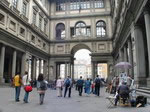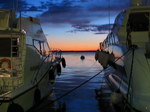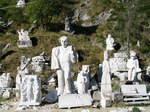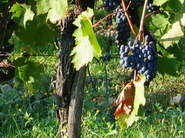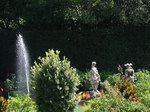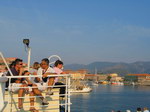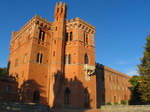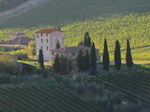The Palio in Siena
The Palio is Siena is more than just a horse race. Twice yearly, the different areas of town compete in one of the most famous and most difficult races in Europe- and do so passionately and with deeply rooted animosities.
Unsaddled horses and mediaeval costumes, flag wavers and drummers, old rituals and the deep emotions of tens of thousands of people all characterise the Palio.
Every year on the second of July and the 16th of August, the most beautiful place in Italy is turned into a lively arena. The Palio is serious business. Television teams broadcast the race live, which consists of riders and horses doing three laps of the large square.
Palio, a competition with tradition
The Palio has taken place in Siena since the 13th century. The race for the silk banner of victory (Palio) only takes 75 seconds, the preparations however, begin months beforehand and form a clearly defined framework.
Rival quarters
An historical procession and the horse race form the end of a whole string of traditional rituals. The preparations begin with the draw of the competing Contrade, the quarters. Because of space restrictions, only 10 of the 17 Contrade can take part in the race. In addition to those who did not take part the previous year and the winner, two Contrade are drawn at random.
Corrupt riders and secret packages
The individual contrade have already picked a jockey, the Fatino, in advance. The Fatini are not from that quarter, but come from the Maremma or all of Italy.
The riders are "bought" just for the Palio, to win the silk banner for the Contrada. The choice of the Fatino is not an easy one, because he not only has to ride well, but also has to resist bribery attempts by the other quarters!
Not only the riders, but also the leaders of the individual Contrade reach agreements beforehand and form alliances against other quarters.
Guarding the horses
A week before the event, a thick layer of sand is spread over the outer rim of the piazza, to protect the horses. Three days before the Palio, a lottery decides which jockey will ride which horse. The horses are closely guarded against the tricks and schemes of the other teams from then on.
Five practice runs prepare the horse and rider for the big night. On the eve of the race, after the final rehearsal, everyone meets in their respective Contrade to enjoy a big meal with good wine.
The day of the Palio
The horses are blessed in the Contrade's respective churches. Finally, the Contrade take part in the traditional procession to the Piazza del Campo, dressed in historical costumes.
Historical procession Corteo Strocio
Every quarter sends flag wavers, drummers, paiges, army leaders and banner carriers, who hold the symbol of the Contrado (goose, snail, tower etc.) high. At the very end of the procession is an extravagantly decorated war cart, pulled by two white bulls, which carries the sought after banner, the Palio.
At the square, a mass of spectators await it, the surrounding balconies and windows are full of enthusiastic spectators.
The raw traditions of the Fantini
At around 8pm, the race begins. The spectators enthusiastically await the start. Ready for anything, the rider and horse jump into the fray at breathtaking speed. Almost anything goes to get the jockeys across the finish line.
Cropping other horses, full contact, pre-made agreements and other rough methods are employed to insure a win. For years, animal protection agencies have been calling for the Palio to be banned on these grounds.
Especially the curve San Martino, which is cushioned by mattresses shows, how dangerous and inconsiderate the Palio can be. The horses can also win the race scosso, without a rider.
Only the win counts
The Palio is tough, only the win counts. The finish is commentated by everything the Italian language has to offer. From euphoric shouts of triumph to the most crude expressions, everything can be heard. The faces say more than word.
After the race, a prayer of thanks is said in church. Finally, the winners and especially the winning horse are enthusiastically celebrated.
{$VAR_EXTRATHEMEN_TEXT}
Copyright
©2004-2011 Ferienlive.de | v6.85
Reproduction, editing, circulation and any form of utilisation of texts, photos, graphics or other data outside the limits of copyright laws are subject to the express permission of us.


